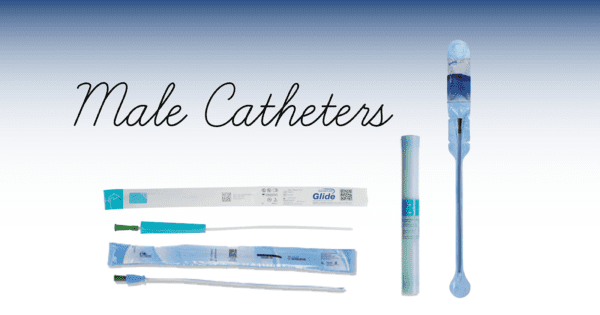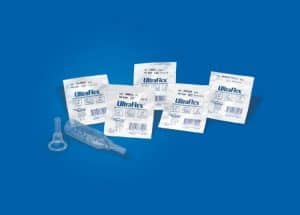Are you searching for more information about male catheters as well as where to buy them? We will discuss the five main types of male catheters to help you better understand them as well as where to purchase male catheters.
Personally Delivered offers a wide array of male catheters at the best prices. Whether you’re using catheters for urinary retention, benign prostatic hyperplasia (BPH), after prostate cancer treatment, or another medical condition, we are sure to have the male catheter option for you.
The Five Types of Male Catheters
Catheters can be used intermittently or stay in the bladder for a more extended period. We will discuss the differences, benefits, and where to buy male catheters in more detail.
The five types of male catheters are:
- Straight male catheters
- Pre-lubricated and hydrophilic male catheters
- Closed system male catheters
- Indwelling Foley catheters
- Male external catheters
1. Straight Male Catheters
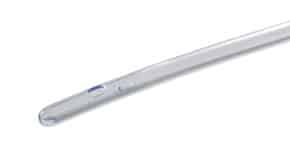 A straight male catheter is a thin, uncoated flexible tube that you insert into the urethra or through a stoma to drain urine from the bladder. Straight male catheters are commonly made of vinyl (PVC), silicone, POBE, or red rubber latex. These types of catheters are intermittent, meaning they are inserted, urine is drained, and then the catheter is withdrawn and discarded after each use.
A straight male catheter is a thin, uncoated flexible tube that you insert into the urethra or through a stoma to drain urine from the bladder. Straight male catheters are commonly made of vinyl (PVC), silicone, POBE, or red rubber latex. These types of catheters are intermittent, meaning they are inserted, urine is drained, and then the catheter is withdrawn and discarded after each use.
Since they are uncoated, straight male catheters require manual lubrication upon insertion for a more comfortable catheterization experience. Sterile catheter lubricant comes in convenient single-use packets or larger tubes.
Straight catheters, like all types of male catheters, may also be available to you as pocket catheters. Straight pocket catheters typically come in a curved or U-shaped package, which you can discreetly tuck into your pocket, bag, or briefcase for easy carrying.
2. Pre-lubricated and Hydrophilic Male Catheters
Hydrophilic male catheters are similar to straight catheters but have a unique coating bonded to the surface. When activated by water, the catheter becomes lubricated and slick, providing smooth and comfortable insertion and catheter removal.
Some types of male hydrophilic catheters require manual activation of the hydrophilic coating, while others come already activated and are ready to go right out of the packaging. The popular GentleCath Glide Male Catheter comes with an included water sachet that is “popped,” and the hydrophilic coating is activated, creating a low-friction surface. The newer SpeediCath Soft Hydrophilic Male Catheter is ready to go when you are since it is pre-lubricated and virtually touch-free.
 Just like hydrophilic catheters, pre-lubricated male catheters don’t require additional lubricating jelly. Pre-lubricated catheters are a “less mess” option as the gel-like sterile lubricant won’t drip like the sterile water or saline does from other hydrophilic male catheter options.
Just like hydrophilic catheters, pre-lubricated male catheters don’t require additional lubricating jelly. Pre-lubricated catheters are a “less mess” option as the gel-like sterile lubricant won’t drip like the sterile water or saline does from other hydrophilic male catheter options.
Most pre-lubricated and intermittent hydrophilic catheters offer a touchless handling sleeve in their packaging to allow the user to handle the catheter without touching the tube itself. This touch-free feature reduces the risk of bacterial contamination from your hands. Cure Medical takes great attention to detail in their hydrophilic catheters. The Cure Ultra Male Catheter features a unique Coverall coating to ensure evenly distributed lubrication down the catheter’s entire length. This technology provides a cleaner, no mess, no dripping catheterization. The gripper sleeve eliminates touching the catheter itself and reduces the risk of contamination and infection. All Cure catheters are free of DEHP, BPA, and natural rubber latex as an added benefit.
Benefits of Hydrophilic Catheters
- Easy-to-use
- Less mess
- Reduced friction and trauma to the urethra
- Reduced risk of contamination and urinary tract infections (UTIs)
- Convenient for carrying and traveling
3. Male Closed System Catheters
 A male closed system catheter is an all-in-one option that includes a pre-lubricated or hydrophilic catheter in its own self-contained sterile collection bag. Sometimes other insertion supplies are included, such as gloves, disinfecting wipes, and an underpad, to make catheterization more hygienic. The completely closed system allows for touchless catheterization, making it an excellent choice for men on-the-go or in wheelchairs because of their convenience. The all-in-one system will enable men to catheterize whenever and wherever there is privacy.
A male closed system catheter is an all-in-one option that includes a pre-lubricated or hydrophilic catheter in its own self-contained sterile collection bag. Sometimes other insertion supplies are included, such as gloves, disinfecting wipes, and an underpad, to make catheterization more hygienic. The completely closed system allows for touchless catheterization, making it an excellent choice for men on-the-go or in wheelchairs because of their convenience. The all-in-one system will enable men to catheterize whenever and wherever there is privacy.
A popular touchless male closed system catheter option is the Hollister VaPro Plus Touch-Free Male Catheter. This catheter is ready-to-use with sterile catheter hydration technology. No receptacle is needed with the integrated collection bag and touch-free protective sleeve and introducer tip.
4. Indwelling Foley Male Catheters
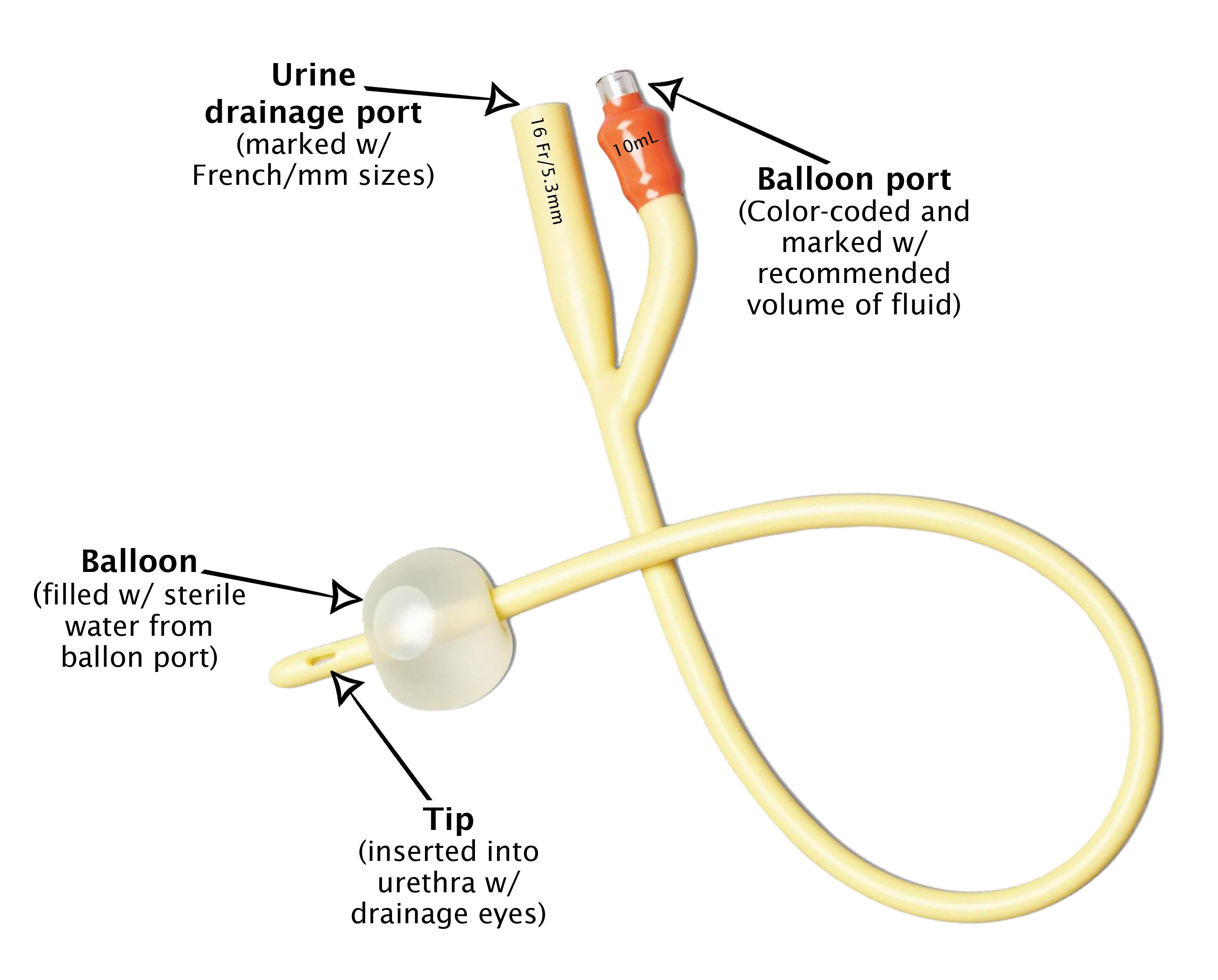 Indwelling Foley catheters stay in the bladder for a more extended period and are inserted by a doctor or nurse. The Foley catheter’s primary purpose is to drain urine from the bladder into a collection device, typically a leg bag or drain bag. A small balloon is inflated near the insertion tip to keep the catheter in place, so it doesn’t slip.
Indwelling Foley catheters stay in the bladder for a more extended period and are inserted by a doctor or nurse. The Foley catheter’s primary purpose is to drain urine from the bladder into a collection device, typically a leg bag or drain bag. A small balloon is inflated near the insertion tip to keep the catheter in place, so it doesn’t slip.
A couple of the examples of Indwelling Foley Catheters that we carry at Personally Delivered are the Cardinal Health Dover 2-Way Straight Foley Catheter and the Coloplast Foley Catheter with 10 cc Balloon.
Since Foley catheters remain inside the body for long periods, the risk of urinary tract infections may increase. However, indwelling catheters may be the right choice for people who are unable to self-cath.
You can learn even more about Foley catheters here.
5. Male External Catheters
Male external catheters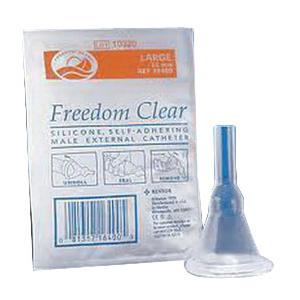 , also referred to as condom catheters or Texas catheters, fit over the penis in the same manner that a condom would. The difference between a regular condom and the male external catheter or condom catheter is that it has a plug at the end to attach a drainage tube so urine can pass into a collection bag or device. Skin-friendly adhesive or soft straps hold the male external catheters in place.
, also referred to as condom catheters or Texas catheters, fit over the penis in the same manner that a condom would. The difference between a regular condom and the male external catheter or condom catheter is that it has a plug at the end to attach a drainage tube so urine can pass into a collection bag or device. Skin-friendly adhesive or soft straps hold the male external catheters in place.
Men who use condom catheters usually wear one for no longer than a day or two at a time. It can be beneficial because they are less likely to cause urinary infections associated with frequent catheterization. Because external catheters allow for more movement and are non-invasive, they can be a more comfortable option.
If deciding that a male external catheter is an option for you, it is essential to make sure you get the right size and fit to prevent leaks, leading to skin irritation and breakdown.
Male Catheter Lengths
 The male urethra is longer than the female urethra, therefore requiring a longer catheter. Male catheters (sometimes known as unisex catheters) are typically 16-inches long. However, there are pocket catheters for men that come in a shorter length to accommodate the compact size for discreetness.
The male urethra is longer than the female urethra, therefore requiring a longer catheter. Male catheters (sometimes known as unisex catheters) are typically 16-inches long. However, there are pocket catheters for men that come in a shorter length to accommodate the compact size for discreetness.
For example, the Coloplast SpeediCath Flex Coude Pro Pocket Catheter is only 13-inches long. It is an excellent choice for discreet carrying in public. It offers hygienic features such as a flexible insertion tip and a unique protective dry-sleeve, so you never directly touch the catheter tube.
Male Catheter French Sizes
Male length catheters come in many different French sizes to accommodate a variety of anatomies. A universal gauge system is used that measures the catheter tube diameter, referred to as a “French size” (Fr). The diameter is taken in millimeters and then multiplied by 3 to result in the French size. For example, if a catheter’s diameter is 5.4 millimeters, the French size is 16.
Most male catheters, except for certain red rubber catheters, follow the universal color-coding system, which allows you to look at the funnel color to ensure you are using the proper prescribed French size.
Your doctor will play an essential role in making sure you are using the right size catheter for your needs. If your catheter is too short, it will not reach the bladder to drain urine sufficiently. On the other hand, if the French size is not wide enough, urine can flow around the tube, causing leakage.
The biggest problem experienced by using a catheter that is too long or wide is pain. Trying to insert a catheter that is slightly larger than the diameter of your urethra will not only be painful but can also be damaging to the tissue.

Straight and Coudé Tips on Male Catheters
There are two different types of catheter insertion tips available on all types of male catheters. There is a straight tip with no bend or curve in it, and then there is a coudé tip, featuring an angle, “elbow,” or bend.
Some men have urethral strictures, enlarged prostates, or blockages and have difficulty passing straight catheters. The doctor may sometimes prescribe a coudé catheter to help bypass tight places. Coudé catheters come in a variety of options for a man’s needs and preferences, such as closed system kits, hydrophilic catheters, and intermittent straight catheters
Coudé catheters are broken down even further into three main types of tips for coudé catheters. These three different types of tips for coudé catheters include:
Tapered Tip Coudé Catheter
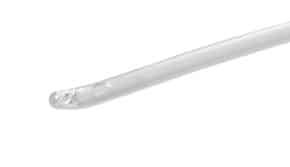 A Tapered Tip Coudé Catheter features a short, strong curve that is smaller at the insertion point. This tip is perfect for navigating through complicated passages or strictures or bypassing enlarged prostates.
A Tapered Tip Coudé Catheter features a short, strong curve that is smaller at the insertion point. This tip is perfect for navigating through complicated passages or strictures or bypassing enlarged prostates.
An excellent example of a tapered tip coudé male catheter is the GentleCath Male Length Coudé Tip Catheter. With its smooth polished eyelets, this tapered tip coudé male catheter facilitates easy insertion.
Olive Tip Coudé Catheter
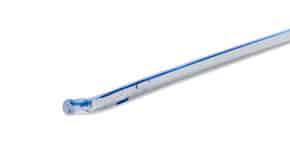 An Olive Tip Coudé Catheter is slightly ball-shaped and rounded with a curve to aid in smooth passage around obstructions to the bladder. The rounded, curved olive insertion tip allows for a smoother passage to the bladder and may bypass false passages or urethral obstructions.
An Olive Tip Coudé Catheter is slightly ball-shaped and rounded with a curve to aid in smooth passage around obstructions to the bladder. The rounded, curved olive insertion tip allows for a smoother passage to the bladder and may bypass false passages or urethral obstructions.
The Coloplast Self-Cath Olive Tip Coudé Catheter is an excellent example of an olive tip coudé male catheter. This particular catheter also features a guide stripe on the length of the catheter to aid in the placement of the angled tip.
Tiemann Tip Coudé Catheter
![]() The Tiemann Tip Coudé Catheter is elongated and tapered and typically more pliable than other coudé tips. This type of catheter tip is beneficial for navigating narrower passages and bypassing strictures. And since the Tiemann tip is flexible, it can also aid in better comfort during catheterization.
The Tiemann Tip Coudé Catheter is elongated and tapered and typically more pliable than other coudé tips. This type of catheter tip is beneficial for navigating narrower passages and bypassing strictures. And since the Tiemann tip is flexible, it can also aid in better comfort during catheterization.
The Rusch Siliconized Tiemann Tip Coudé Catheter is an excellent example of this type of male catheter. It also features a notch on the catheter funnel that determines the tip position for insertion.
How do You Use Male Catheters?
Gather all of the catheter supplies
- A toilet or collection container for urine
- Anti-bacterial soap and warm water or a moist towelette or personal wipe
- Water-soluble lubricating jelly
- Waterproof pad such as a bed pad or underpad
- Clean catheter
Prepare for insertion
- Use warm, soapy water to wash your hands and around the head and tip of your penis. You can also use a moist towelette or personal wipe.
- Sit or lie down with knees bent and place the underpad under your penis. Put the collection container close to you, or if you are using a toilet, make sure to stand directly above it to catch any urine.
- Lubricate the male catheter with the water-soluble lubricating jelly.
- Lubricate the first 7 to 10 inches of the catheter.
- Place the other end of the catheter over the toilet or collection container.
Insertion of the male catheter
- With one hand, hold your penis straight out from your body. Slowly insert the male catheter with the other hand into the opening of your urethra. If the catheter is not going in, stop and take a moment to relax. Never force a catheter.
- Start to empty your bladder.
- Gently push the catheter in about 7 to 10 inches and stop inserting when urine starts to flow.
- Once the urine is flowing, push the catheter in about another inch and hold it in place.
- Slowly remove the catheter when urine stops flowing.
Note: The catheterization process should not hurt or cause sharp pain. If you experience these feelings, remove the catheter and try again.
Troubleshooting Common Catheter Problems
The catheter will not go in.
If the catheter does not go in, do not force it. You could damage sensitive tissue and cause trauma. If you are still unable to insert the catheter after you have stopped for a moment to relax and tried again, contact your doctor or visit your nearest urgent care clinic for immediate assistance.
No urine is draining from the catheter.
Gently rotate the catheter as you insert it in case it is blocked. Sometimes mucus or lubricating jelly can block the drainage eyelets and take a couple of minutes to dissolve. Try gently pushing the catheter a little further up into the penis or pulling it back.
If you are using an indwelling Foley male catheter, check for kinks in the catheter tubing or urine drain bag tubing. Ensure the urine collection bag is positioned below your bladder and the leg straps fit correctly, not to cause any bag obstruction.
Urine is leaking around the catheter.
Also called “bypassing,” urine leaking around the catheter could mean the catheter is blocked or the tubing is kinked. Make sure that you are using the right size catheter prescribed for you. If the catheter is too small, leakage around the catheter is quite common.
There is difficulty inserting or removing the catheter.
If you have pain or discomfort when you insert your catheter, try using more lubricant. When you are pushing the catheter past your prostate (the gland that makes semen), it is common to meet some resistance. Take a deep breath and try to relax before you push the catheter in further. Breathe in, then continue pushing the catheter in as you slowly let your breath out.
Your doctor may have prescribed a size too large for you, which can be very uncomfortable and cause pain. It is wise to contact your doctor and confirm that you are using the correct size male catheter.
There is blood on the catheter or in your urine.
If you notice blood on the catheter, it could be a sign that your urethral opening is too dry. Try using more lubricating jelly to prevent further irritation to the area. If you see blood in the urine, it could mean you have an infection. Contact your doctor for an assessment.
When to Contact Your Doctor
If you experience any of the following symptoms, contact your doctor immediately:
- You have a fever of 100.4°F(38.0°C) or higher, as advised by the CDC(Centers for Disease Control and Prevention)
- Nausea or vomiting
- Your urine is thick, cloudy, or has mucus in it
- Bloody (pink or red) or foul-smelling urine
- You have pain or burning in your urethra, bladder, or abdomen.
- It is too painful, difficult, or uncomfortable to insert your catheter far enough to start your urine flow.
Where to Buy Male Catheters Online
Regardless of a person’s age or gender, all catheters require a prescription from your doctor. Your doctor will evaluate your condition, validate your diagnosis, and provide you with a prescription. You can visit the PersonallyDelivered.com site and shop to purchase a variety of male catheters with that prescription.
Personally Delivered is a leading provider of male catheters. We supply catheters from a wide range of brands from popular catheter manufacturers. It is a top priority of ours to make sure we can accommodate our customers’ diverse needs and preferences by carrying catheter supplies of all types and sizes.
With any questions or concerns about any of the female catheter supplies we offer at Personally Delivered, our Product Experts are just a phone call away and ready to assist.
